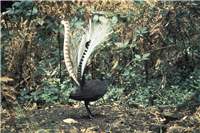Family
Menuridae
Genus
Menura
Species
novaehollandiae
Threats/Control Methods - Regional
Forest clearing for urban development and agriculture is easily the largest threat for this unique species. Bushfires or prolonged droughts also threaten their fragile forest habitat. The ground dwelling nature of Suburb Lyrebirds leave them vulnerable to attacks from European Red Foxes (Vulpes vulpes) and feral Dogs (Canis familiaris) and Cats (Felis catus).
Threats/Control Methods - Local
Rare in the suburbs, young birds in surrounding nature reserves may be attacked by domestic Dogs (Canis familiaris) and Cats (Felis catus).
Local/Urban Actions
Domestic pets are best kept on a leash or in an enclosure in areas close to thick bushland reserves.
Common Names
Superb Lyrebird, Lyrebird, Native Pheasant
Distinguishing Features
The Suburb Lyrebird is a unique-looking species. It is 75-95cm in size, with a small head, a fairly long neck and strong legs and feet. The head and body are grey and wings are rusty-red coloured. Males have extremely long tail feathers. Two of the tail feathers are red-brown, with white patches and curved, while the others have a shimmery silver appearance. Females are smaller and similar except for their tail, which is shorter with plain brown feathers.
Survey Techniques
Call and visual identification.
Species Call
A large range of the clearest and most powerful mimicry of other birds and natural or manmade sounds.
Similar Species
Pilotbirds (Pycnoptilus floccusus) are small birds that are strongly associated with this species, as the occurrence of one indicates the presence of the other. The Albert's Lyrebird (Menura alberti) is an almost identical red-brown coloured species found only in coastal south QLD.
Distribution
This species is only found in the southeastern areas of mainland Australia, from northern NSW down to eastern VIC. Some are also found in southern TAS.
Country of Origin
Australia
Conservation (Pet/Pest) Status - Regional
Tidbinbilla Nature Reserve has long been known for its population of Suburb Lyrebirds. After the 2003 bushfires the species was almost lost, however 2006 surveys show numbers are slowly rising again.
Conservation (Pet/Pest) Status - National
Secure, not listed under the EPBC Act 1999. It is common within its range where habitat remains intact and rare in TAS.
LSCCES Population
Suburb Lyrebirds are rare to this area and the birds seen in the gullies of Black Mountain during the survey period were likely to be refugees from the 2003 Canberra bushfires.
Associated vegetation community
This species is only found in rainforest or wet eucalypt forest, spending time within damp, tree-ferned gullies.
Limiting Resources
This ground dwelling species is sedentary, needing thick ground vegetation and cannot easily travel if its habitat area is threatened by land clearing.
Breeding
The male bird chooses an appropriate nesting territory autumn. After breeding in May, the female takes the sole responsibility of building the nest, incubating the eggs and feeding the chicks. The nest is a bulky and untidy mound of twigs built into crevices or hollowed tree stumps. The one egg is large and grey with light speckles, needing 40-45 days incubation.
Behaviour
The male bird is famous for his beautiful displays. He builds a mound of dirt and leaf litter as a platform on which to show off his long, ornate tail and to sing. During the day, birds can be seen foraging on the ground. During the night they roost in trees. Both males and females have a famous ability to mimic any sounds they hear, including the sounds of distant chainsaws.
Functional Group
Food Species
Supurb Lyrebirds forage through ground litter for insects, worms, spiders and some seeds.
Predators
European Red Foxes (Vulpes vulpes) and feral Dogs (Canis lupus familiaris) and Cats (Felis catus) may attack this species within the forests.
Interesting Fact
It is suspected that some Superb Lyrebirds survived the intense bushfires through Tidbinbilla Nature Reserve by hiding down Wombat (Vombatus ursinus) burrows.
References - (reader suitability of references, P=Primary teachers, S=Secondary students, T=Tertiary students and researchers)
Books:Morcombe, M. 2000. Field Guide to Australian Birds. Steve Parish Publishing. Archerfield. Australia P, S, T
Pizzey, G. 2000. The Graham Pizzey & Frank Knight Field Guide to the Birds of Australia. Angus & Robertson, Sydney. P, S, T
Schodde, R. and Tideman, S. (eds) 1990. Reader's Digest Complete Book of Australian Birds (2nd Edition). Reader's Digest Services Pty Ltd. Sydney. P, S, T
Internet: Birds in Backyards. 2006. [online]. Available at:http://www.birdsinbackyards.net P, S, T
Online Publications:Hinchcliffe, J. 2006. Case Study: Volunteering for a superb cause. Nature Conservation Council of NSW: Hotspots Fire Project. [online]. Available at: http://www.nccnsw.org.au/index.php?option=com_content&task=view&id=1546&Itemid=714 P, S, T
Nix, H. and Cunningham, R. 2006. Birds of the Lower Sullivans Creek Catchment, Canberra ACT. Prepared for the Life in the Suburbs project using data from the Lower Sullivans Creek Catchment Ecological Survey (LSCCES). Australian National University. Canberra. [online]. Available at: http://www.lifeinthesuburbs.com.au/category.php?id=65 S, T

 Top
Top Top
Top